Comfortable Work Boots for Construction Work: What You Must Know.
In the construction industry, it is important to wear proper foot protection i.e. work boots that have been approved by the American National Standards Institute (ANSI) to protect you against hazards in the work zone. As a construction worker, work boots can impact one’s productivity either positively or negatively because the work boots are worn to our feet which support our entire body weight; if the work boots do not fit correctly to our feet, support our movement, and fit well to the kind of job under execution, then we are bound to tire out early; and vice-versa. Wearing work boots that are not comfortable for construction does not stop at impacting construction employee’s productivity, it causes lower back pain, shin splints, and plantar fasciitis among other health issues.
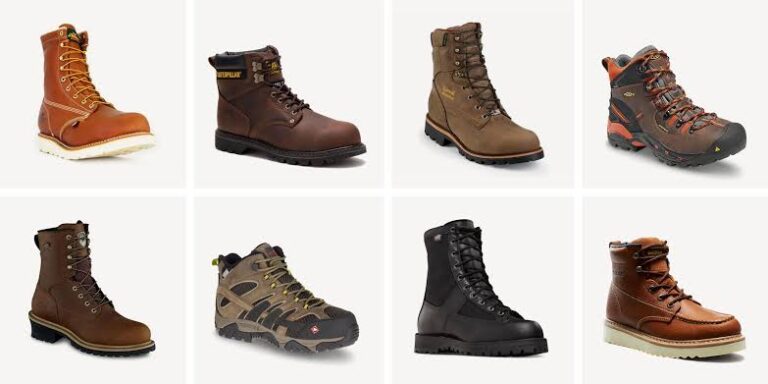
A Sample of Work Boots Applicable to the Construction Industry
How do I Recognize a Standard Work Boot ?
Standard work boots will have an ANSI label inside it. The label will identify the level of protection offered by the work boot for impact, compression, penetration, and electric shock. Through that label, it becomes easy to identify the right work boots for the right job.
A. Features of Safety Boots for Concrete Work
At the mention of construction work, the first construction material that comes to mind is “concrete” because it is the most widely used construction material in the construction industry. However, the construction industry also involves carpentry and ironwork/welding which we will look at in the later sub-sections.
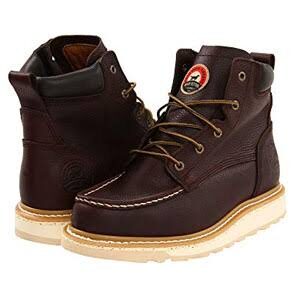
A Sample of Work Boots for Working on Concrete
Concrete floors are among the harshest surfaces to work on because they are completely solid and hard. When a construction worker is looking to get a comfortable work boot for concrete work, the boot should have:
1. Orthotic Insoles with wonderful Arch & Heel Support
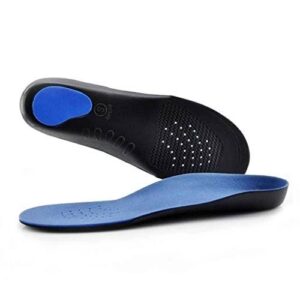
Work Boots’ Insoles
Working on a construction surface involves moving to and fro on a very hard surface without some padding, such a movement causes fatigue to the feet. A work boot should have an insole that allows employees to stand on their feet longer, reduce muscle fatigue in feet and legs, and allow a high level of comfort. It is better when the insole is removable so that it can be easily replaced when due.
2. Rubber Outsole with the Ethylene-Vinyl Acetate (EVA) Traction Tred
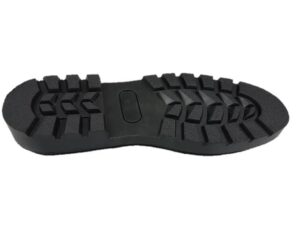
Work Boots’ Outsole with Traction
A dull concrete surface is slip-resistant but concrete surfaces become slippery with snow and mud or any other contaminate on it. Worn concrete surfaces also increase slipperiness. Work boot with a strong rubber outsole and traction improve slip resistance, so, it becomes easy to grip moist floors and walk on slippery surfaces without having to fear the potential of taking a fall.
3. Compression Pads
Lots of stress is associated with getting construction work done. The compression pad absorbs stress, shock and provides comfort to the metatarsal heads, thereby helping the wearer to improve productivity.
4. Tough Full-grain Waxed Leather
During concrete works such as chipping, drilling, and cutting of concrete, the concrete particles can irritate the skin or mix with sweat coming out from the skin to form a caustic solution that burns the skin. High quality leather offers the feet extra comfort and protection against small falling objects and stays strong against a demanding work environment, thereby prolonging the lifespan of the boots. Also, waxed leathers offer resistance against water and other liquids, and they are easy to clean.
4. Breathability
Working on concrete for a long period (about 8 hours) in a very harsh environment can make your feet sweaty and make the inside of your boot smelly. Work boots with mesh lining and design to allow air to pass through it can alleviate the smell. How? The material will allow air to pass through it to cool your feet all day thereby preventing the boots from smelling. Also, breathable boots are easy to dry after they have been washed.
5. Toe Protection
A construction employee working/walking on a concrete slab can accidentally hit his/her foot on rebars that stick out of the concrete slab. A comfortable work boot should have a steel, aluminum or thermoplastic polyurethane (TPU) reinforcement in the toe to offer lasting protection to the foot.
6. Lightweight
Working on concrete involves standing or walking around for a long time. Hence, it is important to avoid heavy work boots. Work boots made from lightweight materials bring a lot of comfort to the wearer which prevents the wearer from having sore feet among other lower body pains. It also allows easy, comfortable, and quicker movements.
7. Puncture Resistance
Construction workers are faced with the hazard of being impaled on rebar sticking out of concrete slabs. Underfoot safety is important to keep the feet of construction workers safe from sharp and heavy objects while working/walking on concrete.
8. Insulation
Working on concrete might involves working outdoors, which can be in very cold weather conditions. It is better to have work boots with a fitted topline that snugs the calf to protect the feet against cold temperatures.
Working In Concrete
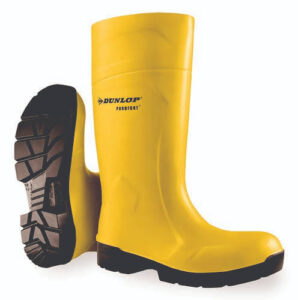
Safety Boots for Working in Concrete
The second aspect of working with concrete is working in concrete; this involves working in wet/fresh concrete such as concrete pouring. This kind of activity involves working inside a pool of concrete, experiencing overexertions, awkward posture, and making awkward movements to control concrete pouring. When looking for work boots to work in concrete, it is best to get work boots that have:
1. Waterproof Ability with High Shaft
Repeated contact of wet concrete with the skin and it washing off, results in chemical burn to the skin or worst, skin ulcer in the long run. These injuries may involve hospitalization and skin grafts. To prevent such hazards it is important to wear work boots with 100% waterproof materials (such as strong rubbers) to keep your feet dry in the wettest of work environments and high enough to prevent concrete from flowing in when workers stand in concrete.
2. Comfort Padding
Lots of stress is associated with working in concrete. The comfort padding will absorb the stress, and the shock and provide comfort to the metatarsal heads, thereby helping the wearer to improve productivity.
3. Durability
Concrete work is rugged but every construction employee wants a boot that would last at least 6 months. It is important to get work boots of very strong and high quality material; which will in turn become durable.
4. Rubber Outsole with Anti-slip and Traction
Fresh concrete is slippery until it dries. So if any bit of it gets to the worker’s boot it can cause the worker to slip, trip and fall. Work boots with traction sole that is heavy and reinforced to provide stability in uneasy terrains are highly recommended to move confidently in concrete.
5. Shock Absorption and Extra Support
Concrete work involves supporting heavy loads. The sole must have some cushioning effect which allows it to absorb any type of shock. Work boots should have extra supports which helps workers carry heavy loads when the muscles are weak, and the ankles are injury-prone.
6. Ability to be Easily Cleaned
Working with concrete last a very long time (at least 8 hours), it won’t be convenient to clean a work boot at intervals while concrete work is ongoing except when it has ended for the day. Concrete on the boot tends to become a difficult stain to remove after a long time, that is why it is important to consider boots that are easy to clean.
7. Lightweight
Working with fresh concrete involves improper lifting, awkward postures, and repetitive movements which can lead to fatigue among other musculoskeletal disorders. Lightweight work boots allow easy leg movement such as shifting one’s feet and taking small steps in the direction one wants to turn.
8. Insulation
Working in concrete involves working outdoors most of the time, which can be in very cold weather. A well-insulated work boot is important to protect the feet against cold temperatures.
9. Safety Toe
Construction workers face the risk of being hit by falling objects from concrete block stacking equipment. It is important to get safety boots with a bumper that is crush resistant and wraps up the toes to protect them from such hazards.
B. Features of Safety Boots for Welding/Ironwork
Ironwork/welding is another section of the construction industry. Prominent steel structures (such as the Eiffel Tower, the Brooklyn Bridge, the Steel house, etc.) would not have been achievable without the service of the ironworkers. Ironworkers are technicians that install structural steels to form steel structures. Welding or ironwork operation is safe but it can be very dangerous if the safety plan is not put in place and strictly adhered to. We will look at the features to consider when looking for a comfortable work boot for welding.
The work boots must have:
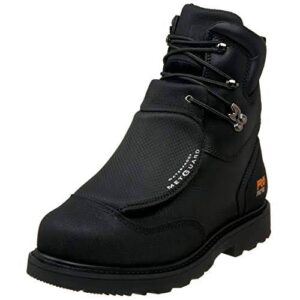
Safety Boot for Welding
1. Electric Hazard Protection
Arc welding requires electricity, so welders face potentially dangerous electric shock. It becomes vital to look for work boots that can protect against the buildup of static electricity on the body which in turn could produce a spark and cause an explosion or fire.
2. Waterproof Ability
Waterproof and water-resistant boots help keep the wearer’s feet dry when working in wet conditions. Good work boots should have waterproof liners to keep water out but allow sweat to escape.
3. Puncture Resistance
Welding involves working with metals. The offcuts from these metals can become very dangerous to the workers if not properly kept as they are usually sharp-pointed and able to pierce through the sole if mistakenly stepped upon. Ironworkers need to select work boots that have puncture-resistant Steel-Flex plate for underfoot safety.
4. Slip Resistant Soles and Great Traction
Metals are slippery to walk upon. Worse, some work locations have inescapable existence of oil, fuel, and other oily aspects. Comfortable work boots must have special soles that are abrasion-resistant and provide traction on wet or oily floors.
5. Heat Resistance Outsole
Welding exposes workers to intense heat – often thousands of degrees – making burn injuries common. It is an added protection that is vastly beneficial to welders, and other workers who are exposed to working environments with hot materials, falling ashes, and other associated risks.
6. Comfort and Fit
Welding by itself is not an easy task, so, it is important to get work boots that fit well and make one feel comfortable while on the job. The work boots should feel good on one’s feet from the second one put them on. Poorly fitting work boots or work boots that require to be broken in might result in foot problems in the long run.
7. Durability
Despite abusive and rugged use of work boots every construction worker still wants them to last a long time (over 6 months).
8. Metatarsal Guards
Some welders have to work in awkward positions such as squatting which hurt their metatarsals. The metatarsal guards provide comfort to the welder in the squat position. It also protects the instep area from impact and compression by heavy objects.
NB: In case the Metatarsal guards do not come with your boot, it can be purchased on amazon
9. Cushioned Collar and Footbed.
Welding involves standing on hard surfaces such as metal and concrete. Cushioned work boots are necessary to set the feet free from pains even after a long day filled with welding and standing on one’s feet. The ankles also require to be supported by a cushioned collar at the top of each boot, to supply convenience instead of rubbing.
10. Stretchable Leather with High Shaft
The boots need to be made up of durable leather that is not only stylish but also waterproof, breathable, stain, and perspiration resistant. Also, work boots with a side zipper, allows for a quick and straightforward on-off.
Other important features to look out for are lightweight and durability
C. Features of Safety Boot for Carpentry/Woodwork
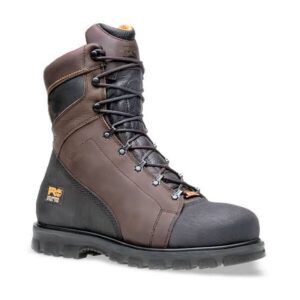
Safety Boot for Woodwork

